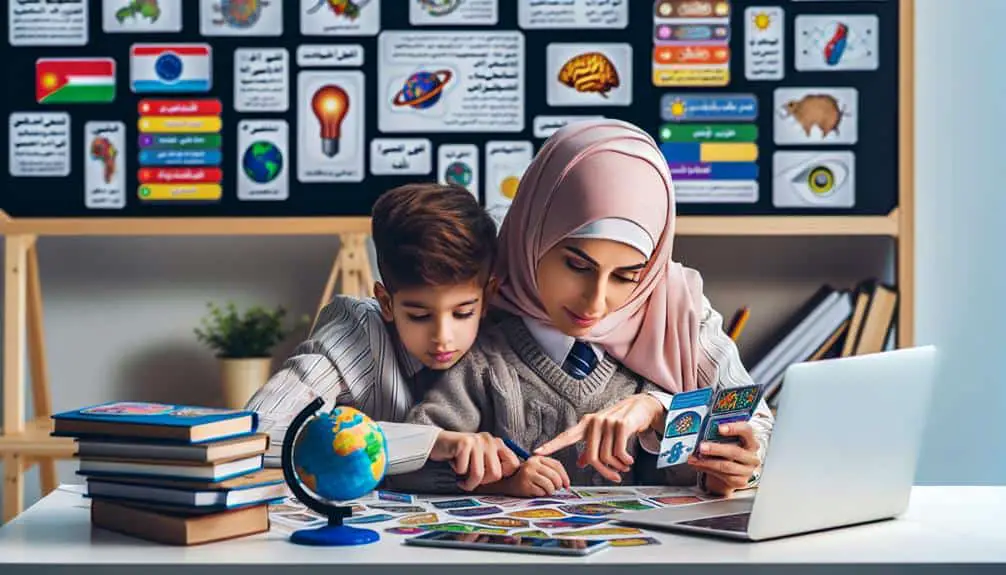In homeschooling, balancing structured lessons with unstructured exploration is essential. Structured learning, like set curriculum, builds discipline, tracking progress, and time management. On the other hand, unstructured learning fuels creativity, encourages self-directed exploration, and nurtures personal interests. Finding this balance is key to a rich learning environment where flexibility meets routine. It guarantees essential topics are covered while fostering deeper engagement and creativity. Understanding diverse learning preferences and personalized instruction are important for effective education. Achieving this balance is the cornerstone of a successful homeschooling journey.
Key Points
- Balance structured lessons for discipline with unstructured exploration for creativity.
- Harmonize routine with flexibility to cater to diverse learning preferences effectively.
- Organized curriculum tracks progress, while unstructured learning encourages self-directed exploration.
- Personalize instruction to engage students based on individual needs and learning styles.
- Adapt teaching methods to create an engaging and effective learning environment.
Understanding Learning Styles in Homeschooling
Understanding learning styles in homeschooling is essential for tailoring education to best suit your child's needs and preferences.
Visual learners, for example, benefit greatly from materials that are presented in a visual format, such as graphs, charts, or videos. If your child is a visual learner, incorporating visual aids into their lessons can greatly enhance their understanding and retention of the material.
Hands-on activities are also vital for engaging kinesthetic learners. These learners thrive when they can manipulate objects or participate in interactive experiences. For instance, conducting science experiments, building models, or engaging in role-playing activities can be effective ways to cater to kinesthetic learners in your homeschooling environment.
Benefits of Structured Learning Approaches
Structured learning approaches offer numerous advantages in homeschooling, providing a clear framework for educational progression and fostering discipline and organization in your child's learning journey. Traditional methods, such as following a set curriculum or daily schedule, can be effective strategies to guarantee that essential subjects are covered and learning goals are met. By incorporating structured learning into your homeschool routine, you can create a predictable environment that helps your child develop a routine and stay focused on their studies.
One of the key benefits of structured learning approaches is the ability to track progress more easily. With clear goals and timelines in place, you can monitor your child's development and address any areas that may need additional attention promptly. Additionally, structured learning can help prepare your child for future academic endeavors by instilling time management skills and the ability to adhere to deadlines. Overall, embracing traditional methods in homeschooling can provide a solid foundation for your child's educational journey and set them up for success in the future.
Embracing Unstructured Learning Opportunities
Exploring unstructured learning opportunities can open up new avenues for creativity and self-directed exploration in your homeschooling approach. By allowing your child to immerse into their passions and interests without rigid guidelines, you foster creativity and a love for learning that goes beyond textbooks and traditional lessons. Unstructured learning provides the freedom for your child to pursue topics that truly captivate their attention, leading to deeper engagement and a more profound understanding of the subject matter.
Encouraging unstructured learning opportunities doesn't mean abandoning all structure. It simply means incorporating flexibility into your homeschooling routine to allow for organic learning experiences. This could involve letting your child choose a project based on their interests, exploring nature, conducting experiments, or even venturing on field trips to museums or historical sites.
Through embracing unstructured learning opportunities, you empower your child to take ownership of their education, encouraging them to think critically, problem-solve, and express themselves creatively. By balancing structured and unstructured learning approaches, you create a well-rounded homeschooling environment that nurtures both academic growth and personal development.
Implementing a Balanced Learning Environment
To establish an effective homeschool learning environment, it's essential to maintain a balance between structured lessons and unstructured exploration opportunities. Finding balance between flexibility and routine is key to creating a harmonious educational setting for your child. Incorporating organized lessons provides a framework that guarantees essential topics are covered, while unstructured exploration allows for creativity and personal interests to blossom.
Flexibility within your schedule enables you to adapt to your child's learning pace and interests, fostering a more engaging learning experience. However, routines offer stability and help instill discipline and consistency in their studies. By blending these elements, you can cater to your child's individual needs while still meeting academic requirements.
Remember that balance isn't about dividing time equally between structured and unstructured activities but rather about integrating them in a way that best suits your child's learning style. Observing your child's reactions and progress will guide you in adjusting this balance to optimize their homeschooling experience.
Catering to Diverse Learning Preferences
Balancing diverse learning preferences in homeschooling requires a nuanced approach that acknowledges individual strengths and challenges. Personalized instruction and individualized curriculum are key components in catering to these varied learning styles. By tailoring lessons to suit the specific needs of each student, you can make certain that they're engaged and making progress in their education.
Flexibility plays an important role in accommodating diverse learning preferences. As a homeschooling parent, you have the autonomy to adjust the pace, content, and teaching methods to suit your child's unique learning style. This flexibility allows you to experiment with different approaches until you find what works best for your child.
It is important to recognize that every student learns differently, and what works for one may not work for another. By embracing personalized instruction, individualized curriculum, flexibility, and autonomy, you can create a learning environment that caters to diverse learning preferences effectively. Through this approach, you can help your child reach their full potential and thrive in their homeschool education.




